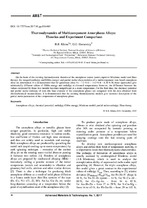| dc.contributor.author | Khina, B. B. | |
| dc.contributor.author | Goranskiy, G. G. | |
| dc.date.accessioned | 2017-11-27T12:10:37Z | |
| dc.date.available | 2017-11-27T12:10:37Z | |
| dc.date.issued | 2017 | |
| dc.identifier.citation | Khina, B. B. Thermodynamics of Multicomponent Amorphous Alloys: Theories and Experiment Comparison / B. B. Khina, G. G. Goranskiy // Advanced Materials & Technologies. – 2017. – № 1. – P. 36-43. | en |
| dc.identifier.uri | https://rep.bntu.by/handle/data/35091 | |
| dc.description.abstract | On the basis of the existing thermodynamic theories of the amorphous matter (semi-empirical Miedema model and Shao theory), the integral (enthalpy and Gibbs energy) and partial molar characteristics of a multicomponent iron-based amorphous alloy are determined. It is demonstrated that for quaternary alloy Fe – 7.3 % Si – 14.2 % B – 8.26 % Ni these approaches give substantially different values of Gibbs energy and enthalpy at elevated temperatures, however, the difference between the values calculated by these two models becomes insignificant at a room temperature. For the first time, the chemical potential and partial molar enthalpy of iron (the base element of the amorphous phase) are compared with the data obtained from electrochemical measurements. It is demonstrated that the existing thermodynamic models give incorrect description of the partial molar parameters of the components of amorphous phase. | en |
| dc.language.iso | en | en |
| dc.title | Thermodynamics of Multicomponent Amorphous Alloys: Theories and Experiment Comparison | en |
| dc.type | Article | ru |
| dc.identifier.doi | 10.17277/amt.2017.01.pp.036-043 | |

